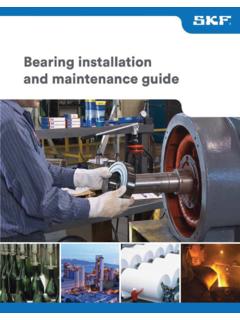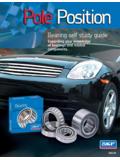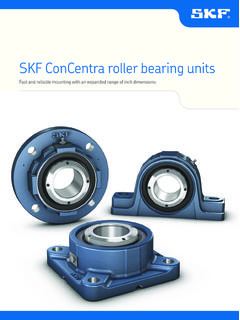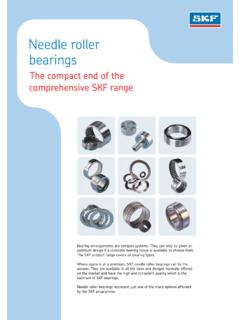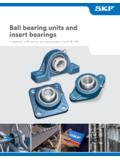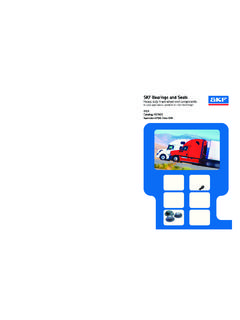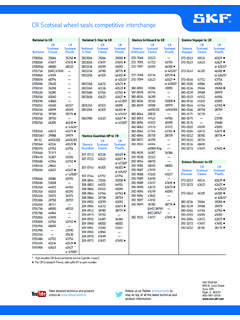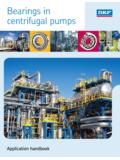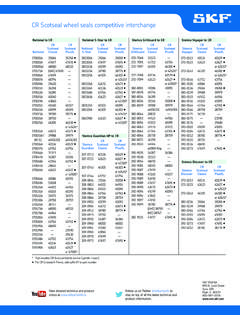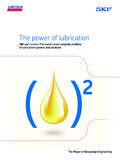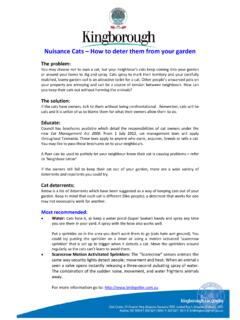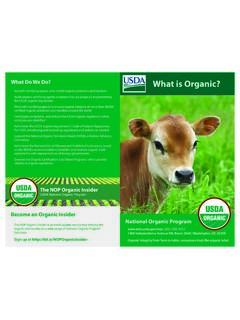Transcription of The SKF model for calculating the frictional moment
1 The SKF model for calculating the frictional moment The SKF model for calculating Zone 2 Mixed lubrication condition, in which a separating oil film carries part of the frictional moment the load, with fewer asperities in contact, Bearing friction is not constant and depends and so friction decreases. on certain tribological phenomena that occur Zone 3 Full film lubrication condition, in in the lubricant film between the rolling ele- which the lubricant film carries the load, but ments, raceways and cages. with increased viscous losses, and so fric- Diagram 1 shows how friction changes, as a tion increases. function of speed, in a bearing with a given Zone 4 Full film lubrication with thermal lubricant. Four zones are distinguishable: and starvation effects, in which the inlet shear heating and kinematic replenishment Zone 1 Boundary layer lubrication condi- reduction factors compensate partially for tion, in which only the asperities carry the the viscous losses, and so friction evens off.
2 Load, and so friction between the moving surfaces is high. To calculate the total frictional moment in a rolling bearing, the following sources and their Diagram 1. Bearing frictional moment as a function of speed or viscosity frictional moment 1 2 3 4. Speed Boundary layer Mixed lubrication Full film lubrication Full film lubrication with lubrication thermal and starvation effects = Load = Load share carried by asperities = Load share carried by lubricant film 1. Friction tribological effects must be taken into constant speed, below the speed ratings account: bearing does not exceed the limits of misalignment the rolling frictional moment and eventual effects of high-speed starvation and inlet For paired bearings, the frictional moment can shear heating be calculated separately for each bearing and the sliding frictional moment and its the results added together.
3 The radial load is effect on the quality of the lubrication divided equally over the two bearings; the axial the frictional moment from seal(s) load is shared according to the bearing the frictional moment from drag losses, arrangement. churning, splashing etc. NOTE: The formulae provided in this section The SKF model for calculating the frictional lead to rather complex calculations. Therefore, moment closely follows the real behaviour of SKF strongly recommends calculating the fric- the bearing as it considers all contact areas tional moment using the tools available online and design changes and improvements made at to SKF bearings, including internal and exter- nal influences. The SKF model for calculating the frictional Rolling frictional moment moment uses The rolling frictional moment can be calcu- lated using M = Mrr + Msl + Mseal + Mdrag Mrr = fish frs Grr (n n)0,6.
4 Where M = total frictional moment where Mrr = rolling frictional moment Mrr = rolling frictional moment [Nmm]. Msl = sliding frictional moment ( page 5) fish = inlet shear heating reduction factor Mseal = frictional moment of seals ( page 11) frs = kinematic replenishment/starvation Mdrag = frictional moment of drag losses, reduction factor ( page 4). churning, splashing etc. ( page 12) Grr = variable ( table 1, page 6), depending on: The SKF model is derived from more advanced the bearing type computational models developed by SKF. It is the bearing mean diameter dm [mm ]. valid for grease or oil lubricated bearings and = 0,5 (d + D). is designed to provide approximate reference the radial load Fr [N]. values under the following application the axial load Fa [N].
5 Conditions: n = rotational speed [r/min]. n = actual operating viscosity of the oil or grease lubrication: the base oil of the grease [mm2 /s]. only steady state conditions (after several hours of operation). lithium soap grease with mineral oil bearing free volume filled approximately 30%. ambient temperature 20 C (70 F) or higher oil lubrication: oil bath, oil-air or oil jet viscosity range from 2 to 500 mm2 /s loads equal to or larger than the recom- mended minimum load constant loads in magnitude and direction normal operating clearance 2. The SKF model for calculating the frictional moment Inlet shear heating reduction factor Fig. 1. A fraction of the overall quantity of oil within a bearing passes through the contact area; only a tiny amount is required to form a hydrody- namic film.
6 Therefore, some of the oil close to the contact area is repelled and produces a Reverse flow reverse flow ( fig. 1). This reverse flow shears the lubricant and generates heat, which lowers the oil viscosity and reduces the film thickness and rolling friction. For the effect described above, the inlet shear heating reduction factor can be esti- mated using 1. fish = JJJJJJJJJJJJKLL. 1 + 1,84 10 (n dm)1,28 n0,64. 9. where fish = inlet shear heating reduction factor ( diagram 2). n = rotational speed [r/min]. dm = bearing mean diameter [mm]. = 0,5 (d + D). n = actual operating viscosity of the oil or the base oil of the grease [mm2/s]. Diagram 2. Inlet shear heating reduction factor fish fish 1,0. 0,9. 0,8. 0,7. 0,6. 0,5.
7 0,4. 0,3. 0,2. 0,1. 0. 9. 0 0,4 0,8 1,2 1,6 2,0 10. 1,28 0,64. (n dm) n 3. Friction Kinematic replenishment/starvation reduction factor For oil-air, oil jet, low level oil bath lubrication ( oil level H lower than the centre of the lowest rolling element) and grease lubrication methods, continuous over-rolling displaces excess lubricant from the raceways. In appli- cations where viscosity or speeds are high, the lubricant may not have sufficient time to replenish the raceways, causing a kinematic starvation effect. Kinematic starvation reduces the thickness of the hydrodynamic film (decreasing k value) and rolling friction. For the type of lubrication methods described above, the kinematic replenishment/starva- tion reduction factor can be estimated using frs = 1.
8 Kz Krs n n (d + D). e 2 (D d). where frs = kinematic replenishment/starvation reduction factor e = base of natural logarithm 2,718. Krs = replenishment/starvation constant: = 3 10 8 low level oil bath and oil jet lubrication = 6 10 8 grease and oil-air lubrication KZ = bearing type related geometric constant ( table 4, page 14). n = actual operating viscosity of the oil or the base oil of the grease [mm2/s]. n = rotational speed [r/min]. d = bearing bore diameter [mm]. D = bearing outside diameter [mm]. 4. The SKF model for calculating the frictional moment Sliding frictional moment EHL = sliding friction coefficient in full-film The sliding frictional moment can be calcu- conditions lated using Values for EHL are: 0,02 for cylindrical roller bearings Msl = Gsl sl 0,002 for tapered roller bearings Other bearings where 0,05 for lubrication with mineral oils Msl = sliding frictional moment [Nmm] 0,04 for lubrication with synthetic oils Gsl = variable ( table 1, page 6), depending 0,1 for lubrication with transmission on.
9 Fluids the bearing type the bearing mean diameter dm [mm] Diagram 3 shows the influence of lubrication = 0,5 (d + D) conditions on the weighting factor for the the radial load Fr [N] sliding friction coefficient: the axial load Fa [N]. sl = sliding friction coefficient For full-film lubrication (corresponding to large values of k), the value of fbl tends to Effect of lubrication on sliding friction zero. The sliding friction coefficient for full-film and For mixed lubrication, which can occur when mixed lubrication conditions can be estimated lubricant viscosity or the bearing speed is using low, the value of fbl tends to 1, as contact between asperities occurs and friction sl = fbl bl + (1 fbl) EHL increases. where sl = sliding friction coefficient fbl = weighting factor for the sliding friction coefficient 1.
10 = JJJJJJJLL 8 (n n)1,4 d e2,6 10 m Diagram 3. Weighting factor f bl for the sliding friction coefficient ( diagram 3). e = base of natural logarithm 2,718 fbl n = rotational speed [r/min] 1,0. n = actual operating viscosity of the oil or the 0,9. base oil of the grease [mm2/s]. dm = bearing mean diameter [mm] 0,8. = 0,5 (d + D). 0,7. bl = constant depending on movement: = 0,12 for n 0 0,6. = 0,15 for n = 0 (starting torque 0,5. calculation). 0,4. 0,3. 0,2. 0,1. 0. 5 6 7 8. 10 10 10 10. 1,4. (n n) dm 5. Friction Table 1a Geometric and load dependent variables for rolling and sliding frictional moments radial bearings Bearing type Rolling frictional variable Sliding frictional variable Grr G sl Deep groove ball bearings when Fa = 0 when Fa = 0.
